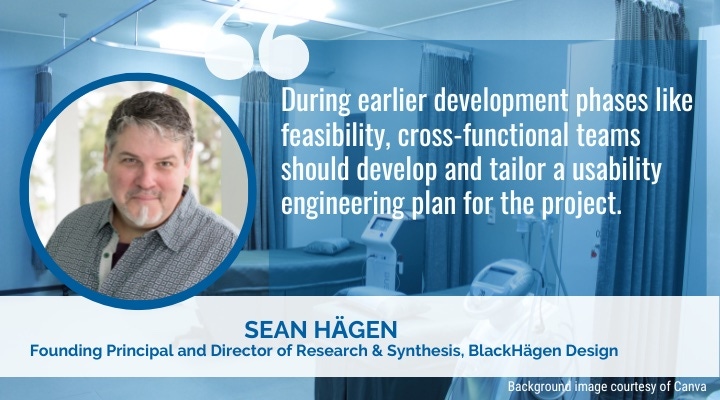What’s the Latest in Human Factors Engineering?
Consider developing a usability engineering plan and don’t mix up UFMEA and URRA, says an expert in human factors engineering.
July 15, 2022

Including human factors and usability engineering processes during medical device development increases the chances that new devices will be safe and effective for intended users, uses, and use environments, according to FDA. The agency’s guidance, Applying Human Factors and Usability Engineering to Medical Devices, aims to help manufacturers in this endeavor.
Sean Hӓgen, BlackHägen Design’s founding principal and director of research & synthesis, recently led a virtual panel discussion with FDA to explore the latest approaches to human factors studies. The panel, “Improving the Safety and Effectiveness of Medical Devices Through Human Factors Considerations: An FDA Interactive Session,” was part of the Human Factors and Ergonomics Society International Healthcare Symposium and included Janine Purcell Human Factors Reviewers, FDA/CDRH/OPEQ; Hannniebey Wiyor, PhD, Lieutenant, USPHS; and Kimberley Kontson, FDA CDRH.
Design News asked Hӓgen a few questions about human factors engineering and what engineers can expect moving forward.
At what point do medical device design engineers typically get involved with (or should get in involved with) human factors studies? During formative or summative studies, or both or neither?
Hӓgen: The short answer is as early in the design process as possible, certainly during formatives. Having designers and engineers getting involved with HFE [human factors engineering] early in feasibility and device definition is best practice, providing the most potential for an optimal user experience while reducing both commercial and safety risks. Design is supposed to be done and frozen by the summative usability validation test.
Do engineers work directly with patients or patient safety researchers? How can BlackHägen Design help?
Hӓgen: Typically, development engineers do not interact with patients, but human factors engineers often do. If the device has a user interface that a patient directly interacts with, they will be recruited for usability studies, which are conducted by usability specialists, typically HFE, in a controlled lab or simulated environment. Design development team members often can observe these studies in real time and contribute questions.
If engineers don’t work directly with patients, how can engineers be sure to get the right information they need to iterate designs?
Hӓgen: If HFE is involved early, there are methodologies like contextual inquiry and comparative studies where the development team can watch and be provided with relevant design inputs at the systems engineering level. There should be a portion of the Design History File, called the Usability Engineering File (per IEC 62366-1), where a rigorous HFE process documents usability engineering activities and design inputs, such as inputs into system-level requirements. The Usability Engineering File is accessible by the entire team.
Can you explain some common pitfalls design engineers may face when it comes to human factors studies? What are some potential solutions?
Hӓgen: Utilizing HFE as a quality engineering checklist, which implies a retrospective engagement at the end of the development process, rather than a proactive means of creating design inputs earlier on. During earlier development phases like feasibility, cross-functional teams should develop and tailor a usability engineering plan for the project.
Please define UFMEA and URRA and when it would be appropriate to employ either one.
Hӓgen: This is a hot topic in the usability world and even within FDA; the perspective and opinions vary. The development of a use-related tool that complements the established Failure Modes and Effects Analysis (FMEA) tool used in product development is still evolving. However, it cannot be the same tool since an FMEA assesses risks based on system and component reliability, not potential use error. You can’t simply put a “U” in front of the acronym and be done. A Use-Related Risk Assessment (URRA) may share elements with a FMEA but rarely has the same metrics for tracking the process of design controls that mitigate risks and the subsequent residual risks so as not to duplicate traceability information in two different documents. It also may have more detail regarding scenarios, tasks, user types, and characterization of use error in order to inform design mitigations, e.g., Perception Cognitive Action analysis. FDA has made available a version of an URRA for reference and inclusion in submissions.
The panel discussion with FDA highlighted human factors as related to improving the safety and effectiveness of medical devices and systems? Why is there a need for improvement?
Hӓgen: In my opinion, FDA is sensitive to the ever-changing landscape of healthcare scenarios, device technologies, integration of medication and delivery systems, software, and AI applications that clinicians and patients must interact with, etc. Consequently, FDA’s processes, methodologies, and policies have to continue to evolve.
Were there any other takeaways from the panel discussion that would apply to design engineers?
Hӓgen: FDA’s potential to be effective is dependent on industry remaining very engaged in providing inputs to their processes and technologies. Manufacturers should engage the agency early before submissions to gain alignment on a human factors engineering approach.
About the Author(s)
You May Also Like



